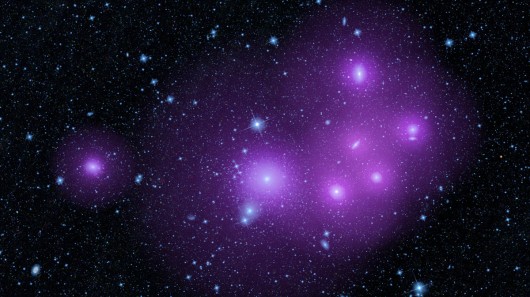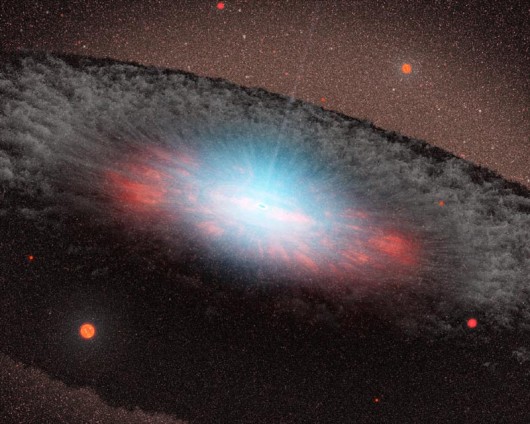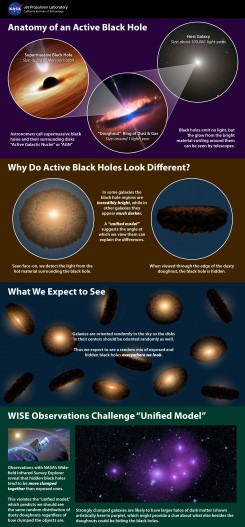Black hole doughnut theory cast into doubt
By Anthony Wood
May 25, 2014

Image of the Fornax cluster of galaxies with artistically enhanced purple areas representing the dark matter halos believed to surround the grouping (Image: NASA/JPL-Caltech)
A fresh analysis of data collected by NASA's WISE telescope has cast doubt on the widely accepted unified model for the composition of black holes. The study examined 170,000 supermassive black holes, and will require scientists to present new theories on the structure of these stellar giants.
At the center of each galaxy lies a supermassive black hole. The gravity of this all-consuming behemoth is so great that even light is unable to escape the event horizon. However, despite this, we are still able to observe them. This is because the gas that a black hole feeds on and uses to grow bigger becomes extremely hot as it nears the event horizon, thus giving the impression that the black hole itself is shining brightly.
The current model explaining the composition of black holes, first put forward in the 1970s, sought to answer why some black holes looked so radically different when compared to others. The unified theory answered these mysteries by making it a question of perspective. The theory postulated that each black hole is surrounded by a doughnut-like ring of dense gas known as a torus. The existence of this ring means that, depending on the angle from which the black hole is observed, it may either appear clear or completely obscured, thus explaining why there is a disparity in appearance.
This artists impression shows the expected composition of a supermassive black hole under the unified theory (Image: NASA/JPL-Caltech)
However, analysis of the data from WISE has failed to validate the unified theory. "Our finding revealed a new feature about active black holes we never knew before, yet the details remain a mystery," states Lin Yan of NASA's Infrared Processing and Analysis Center (IPAC). The new study focused on measuring the level of clustering in both obscured and clearly visible black holes. If the unified theory was correct, there would be no disparity in grouping between the two types of black holes, as they are simply the same cosmological object observed from a different angle. However, analysis of the data showed a significant increase in the level of clustering for black holes with an obscured core, leading to the conclusion that the two types of black holes are possibly not identical in their makeup.
Scientists believe that dark matter, arguably the most enigmatic material in the universe, may be responsible for the unexpected readings. Each galaxy is understood to be surrounded by a halo of dark matter, and it has been discovered that galaxies with a hidden black hole boast a significantly larger halo. While the team members do not believe that the halos themselves are responsible for concealing the black holes, it is possible that the high level of gravitational pull thrown out by larger, more powerful halos of dark matter may provide a clue to understanding the clustering.
NASA infographic on the composition of supermassive black holes (Image: NASA/JPL-Caltech/NOAO/AURA/NSF/ESO)
Looking forward, the team intends to further analyze the WISE data in an attempt to shine a light on this unsettling mystery. The team's research on the unexpected clustering in black holes can be found in The Astrophysical Journal.
Source: NASA
Copyright © Gizmag 2003 - 2014
http://www.gizmag.com/blackhole-doughnut-theory-wise-nasa-dark-matter/32230

